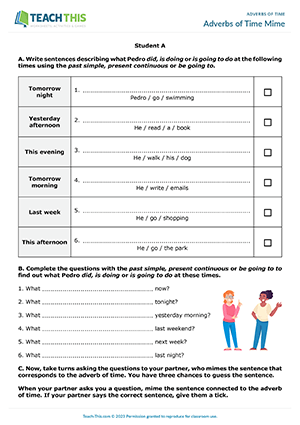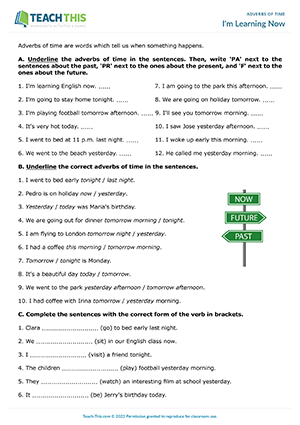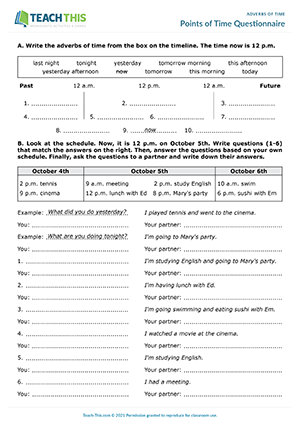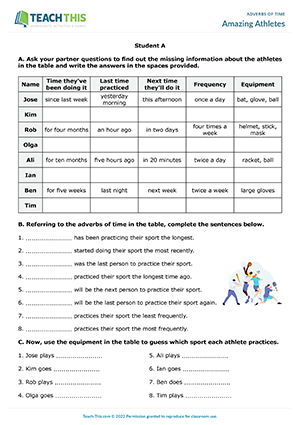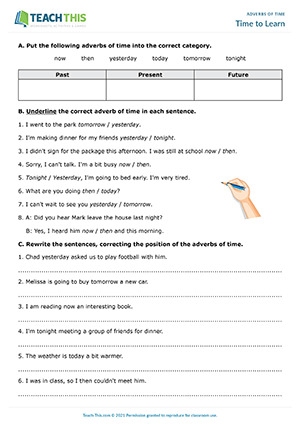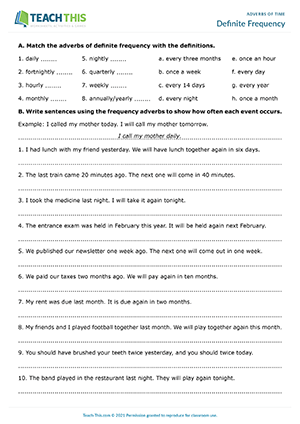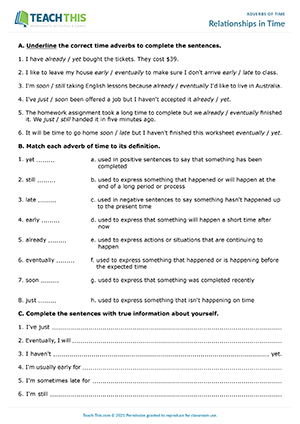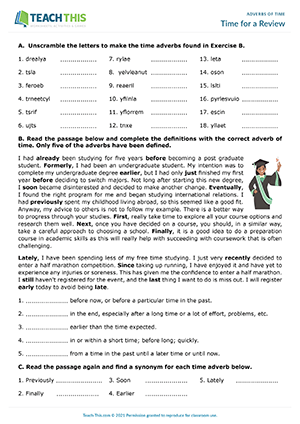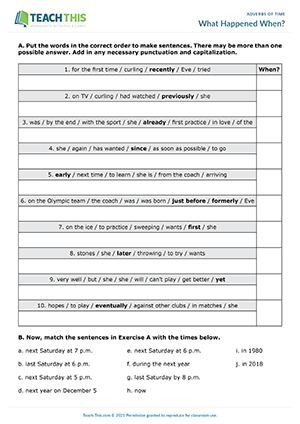This amusing adverbs of time game helps students practice time adverbs and their related tenses. First, in two groups, students write sentences from prompts using the past simple, present continuous or be going to, depending on the adverb of time next to the sentence. Next, students complete questions with the past simple, present continuous or be going to, depending on the adverb of time used at the end of the question. Students then pair up with someone from the other group and take turns asking the questions to their partner, who mimes the sentence that corresponds to the adverb of time in the question. The other student then has three chances to guess what the sentence is using the correct tense. If the student is able to form the sentence shown on their partner's worksheet, their partner puts a tick. The student with the most correct guesses at the end of the game wins.
In this comprehensive adverbs of time worksheet, students learn and practice 12 time adverbs. First, students identify the adverb of time in each sentence and indicate whether the sentence is about the past, present or future. Students then underline the correct adverbs of time in a set of sentences. Next, students complete sentences by putting verbs in their correct form. After that, students complete sentences about Tara's weekend with adverbs of time. Lastly, students complete sentences containing adverbs of time with their own answers.
In this insightful adverbs of time speaking activity, students conduct a questionnaire to help them learn and practice adverbs expressing definite points of time. Students begin by writing adverbs of time from a box on a timeline. Next, students read a schedule and answers to questions. Students then write questions using adverbs of time that match the answers. After that, students answer questions based on their own schedule. Finally, students ask the questions to a partner and write down their answers.
In this engaging adverbs of time speaking activity, students exchange and complete information about athletes using time adverbs. First, students find out missing information about the athletes in a table by asking and answering questions and completing the table with the corresponding information. After that, students refer to the adverbs of time in the table and complete sentences about the athletes. Finally, students refer to the equipment the athletes use and guess which sports they practice.
In this free adverbs of time worksheet, students learn and practice definite time adverbs related to points of time. To begin, students categorize six definite adverbs of time. Next, students underline the correct adverb of time in each sentence shown. After that, students rewrite sentences, correcting the position of the adverbs of time. Students then look at someone's weekly schedule and answer questions about it using time adverbs. Finally, students discuss questions with a partner using the adverbs of time from the worksheet.
Here is a productive adverbs of definite frequency worksheet for intermediate students. Students start by matching adverbs of definite frequency with definitions. Next, students read sentences about when events happen and write sentences using definite frequency adverbs to show how often each event occurs. Students then rewrite sentences, changing adjectives of frequency into adverbs of frequency. Finally, students complete sentences containing definite frequency adverbs with their own information. Students then ask a partner what they wrote and write down their answers.
This detailed time adverbs worksheet can be used to introduce students to indefinite adverbs that demonstrate relationships in time. First, students underline the correct adverbs of time in a set of sentences. Next, students match time adverbs to their definitions. Students then use their own ideas to complete sentences with true information about themselves. After that, students do a gap-fill exercise where they complete a conversation with the adverbs of time from Exercise B. In the last exercise, students use time adverbs to answer comprehension questions about the conversation.
In this useful indefinite adverbs of time worksheet, students review indefinite time adverbs that demonstrate relationships in time. To start, students unscramble letters to make adverbs of time found in the reading. Next, students read the text and complete definitions with the correct adverbs of time. Students then read the text again and find a synonym for each time adverb shown. After that, students use the time adverbs from the previous exercises to complete sentences. Finally, students use the prompts provided to make sentences using adverbs of time.
In this fun adverbs of time game, students race to put words in the correct order to make sentences containing adverbs of indefinite time. The first team to show and then read out each sentence in the correct order wins three points. Teams that show or read out a wrong answer lose one point. This continues until all the sentences have been completed. When the students have finished, they match the sentences with times. The first team to do this scores an additional five points. The team with the highest score at the end of the game wins.
Latest Free
Resources
- Everyday Objects Bingo
Everyday Objects
Elementary (A1-A2)
- Action Verb Races
Actions
Elementary (A1-A2)
- Birthday Basics
Birthdays
Elementary (A1-A2)
- Sales Phrasal Verbs
Business Phrasal Verbs
Upper-intermediate (B2)
Latest Member
Resources
- Collocations at Work
Business Collocations
Intermediate (B1)
- Etiquette Trivia Board Game
Etiquette and Manners
Upper-intermediate (B2)
- Everyday Objects Vocabulary
Everyday Objects
Pre-intermediate (A2)
- Let's have a talk
Verb-Noun Collocations
Pre-intermediate (A2)



